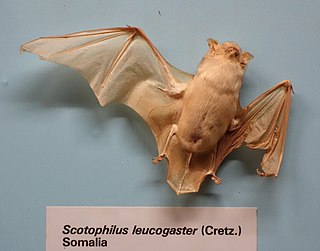
The white-bellied yellow bat or white-bellied house bat, is a species of vesper bat in the genus Scotophilus, the house bats. It can be found in Angola, Benin, Botswana, Burkina Faso, Cameroon, Central African Republic, Chad, Ivory Coast, Gambia, Ghana, Guinea, Guinea-Bissau, Kenya, Mali, Mauritania, Namibia, Niger, Nigeria, Senegal, Sierra Leone, Sudan, Togo, Uganda, and Zambia. It is found in dry and moist savanna and open woodland. It is a common species with a very wide range, and the International Union for Conservation of Nature has assessed its conservation status as being of "least concern".
The Zulu serotine, also called the Zulu pipistrelle, aloe bat, or aloe serotine, is a species of vesper bat found in Angola, Botswana, Democratic Republic of the Congo, Ethiopia, Kenya, Malawi, Namibia, South Africa, South Sudan, Uganda, Zambia, and Zimbabwe. Its natural habitats are savanna and hot deserts.
The montane hylomyscus or montane wood mouse is a species of rodent in the family Muridae. A long-coated species with brownish-grey upper parts and whitish-grey underparts, it occurs in the uplands of tropical Central Africa where its natural habitat is tropical moist montane forests.
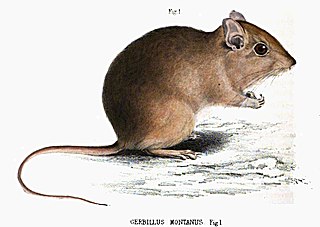
The highveld gerbil is a species of rodent found in Angola, Botswana, Lesotho, Namibia, South Africa, Eswatini, Zambia, and Zimbabwe. Its natural habitats are dry savanna, temperate shrubland, subtropical or tropical dry shrubland, temperate grassland, and temperate desert. This is a common species with a wide range and the International Union for Conservation of Nature has rated it as being of "least concern" as of 2008.

The little rush warbler or African bush warbler is a species of Old World warbler in the family Locustellidae.

The white-browed scrub robin, also known as the red-backed scrub-robin, is a species of bird in the family Muscicapidae. It is native to sub-Saharan Africa, especially East and southern Africa. Within range, its Turdus-like song is one of the often-heard sounds of the bush. The flitting of the tail is characteristic of this species, but also of some near relatives.
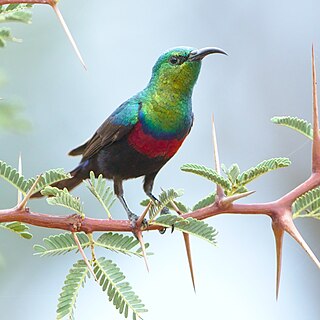
The Marico sunbird is a species of bird in the family Nectariniidae, which is native to woodlands of the eastern and southern Afrotropics.The bird is typically found in the southeast of the continent of Africa. It is of least concern on the IUCN Red List and has an unknown population size that has yet to be quantified. The Marico sunbird has conservation regions located all over its range, so it is unlikely to go extinct.

The bearded woodpecker is a species of bird in the family Picidae. It has a distinctive black and white head and brownish barred body. It is native to tropical central Africa. It has an extremely wide range and is a fairly common species, and the International Union for Conservation of Nature has rated its conservation status as being of "least concern". Some taxonomic authorities place this species in Dendropicos.

The Mohol bushbaby is a species of primate in the family Galagidae which is native to mesic woodlands of the southern Afrotropics. It is physically very similar to the Senegal bushbaby, and was formerly considered to be its southern race. The two species differ markedly in their biology however, and no hybrids have been recorded in captivity.
The rock dormouse or flat-headed African dormouse is a species of rodent in the family Gliridae. It is found in Botswana, Mozambique, South Africa, Eswatini, Zambia, and Zimbabwe where it lives among rocks in upland areas. It is a fairly common, mainly nocturnal species and the International Union for Conservation of Nature has assessed its conservation status as being of "least concern".

The reddish-gray musk shrew is a species of mammal in the family Soricidae. It is found in Angola, Botswana, Democratic Republic of the Congo, Eswatini, Lesotho, Malawi, Mozambique, Namibia, Nigeria, South Africa, Tanzania, Zambia, and Zimbabwe. Its natural habitats are lowland forests, subtropical or tropical high-elevation grassland, and caves.
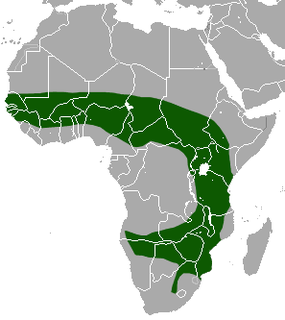
The bicolored musk shrew is a species of mammal in the family Soricidae. It is found in Angola, Benin, Botswana, Burkina Faso, Burundi, Cameroon, Central African Republic, Chad, Democratic Republic of the Congo, Ivory Coast, Ethiopia, Gambia, Ghana, Guinea, Guinea-Bissau, Kenya, Lesotho, Malawi, Mali, Mauritania, Mozambique, Namibia, Niger, Nigeria, Rwanda, Senegal, Sierra Leone, South Africa, Sudan, Tanzania, Togo, Uganda, Zambia, and Zimbabwe. Its natural habitats are savanna, subtropical or tropical dry lowland grassland, and hot deserts.

The lesser red musk shrew is a species of mammal in the family Soricidae. It is found in Angola, Botswana, Democratic Republic of the Congo, Malawi, Mozambique, Namibia, South Africa, Eswatini, Tanzania, Zambia, and Zimbabwe. Its natural habitat are savanna, subtropical or tropical dry lowland grassland, and hot deserts.

The Ugandan musk shrew is a species of mammal in the family Soricidae. It is found in Uganda, the Democratic Republic of Congo and the Central African Republic. Its range, population size and habits are poorly known.

The African giant shrew is a species of white-toothed shrew. It also is known as, Mann's musk shrew, Euchareena's musk shrew, or Olivier's shrew. It is native to Africa, where it has a widespread distribution and occurs in many types of habitat. Its natural habitats are subtropical or tropical dry forest, subtropical or tropical moist lowland forest, subtropical or tropical moist montane forest, dry savanna, moist savanna, arable land, rural gardens, urban areas, and heavily degraded former forest. In the Nile Valley it is found near human habitation, where it is considered to be a pest. It is a common species and is listed by the International Union for Conservation of Nature as being of "least concern".

The lesser gray-brown musk shrew is a species of mammal in the family Soricidae. It is found in Angola, Malawi, Mozambique, South Africa, Swaziland, Tanzania, Uganda, Zambia, and Zimbabwe. Its natural habitats are dry savanna, subtropical or tropical dry shrubland, Mediterranean-type shrubby vegetation, subtropical or tropical high-elevation grassland, and rocky areas.

Kihaule's mouse shrew is a species of mammal in the family Soricidae endemic to Tanzania where it is known only from the Udzungwa Mountains, at the western end of the Eastern Arc Mountains. Its natural habitats are subtropical or tropical moist montane forests and plantations. It is threatened by habitat destruction and the International Union for Conservation of Nature has assessed its conservation status as being "endangered". It was named after Philip M. Kihaule, a medical-entomological technician, who considerably contributed to the documenting of the small mammals of Tanzania and collected the type specimen of this shrew.
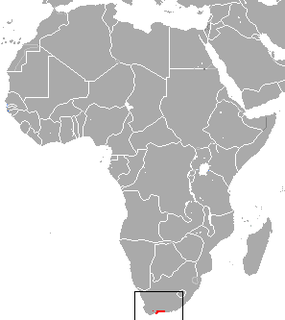
The long-tailed forest shrew, or long-tailed mouse shrew, is a species of mammal in the family Soricidae. It is endemic to South Africa, where its natural habitats are Mediterranean-type shrubby vegetation and swamps.

The Peters's epauletted fruit bat is a species of megabat in the family Pteropodidae. It is found in Angola, Botswana, Democratic Republic of the Congo, Eswatini, Malawi, Mozambique, Namibia, Tanzania, Zambia, and Zimbabwe. Its natural habitat is in riverine or evergreen forest, or moist woodland, where there are fruit-bearing trees.

Darling's horseshoe bat is a species of bat in the family Rhinolophidae found in Africa. Its natural habitats are dry savanna, caves and other subterranean habitats.


















